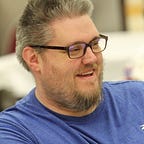Fritz Koenig is an unlikely name with which to start a 20th anniversary September 11th remembrance. He didn’t die aboard an airplane or in a Tower. In 2001, Koenig was a 77-year-old German Sculptor still winning prizes for his art. He was known for his use of basic geometric shapes to tell a story in sculpture. His involvement in the September 11th story started over 30 years earlier when he won a commission for a sculpture in fountain square, between the still-under-construction World Trade Center’s twin towers.
The day the 25-ton bronze statue was installed was sunny and calm. The sculpture is officially titled “Große Kugelkaryatid N.Y.,” but is popularly known as “The Sphere.” It stood amid bustle of the World Trade Center site for 30 years as a symbol of peace through commerce. That was, until September 11, 2001 when the fury of a storm beyond the realm of understanding descended upon it.
This wasn’t a natural disaster. This storm was man-made. It rocked the towers and poured down a rain of steel, paper, and dust. The eye of the storm visited New York, Washington, and Shanksville that day.
The impact of the storm front, though, was felt from sea to shining sea. It did physical damage and left emotional scars.
You know what, though? Our artist, Fritz Koenig, made quite a sculpture. Because, like a lighthouse beacon along a rugged coast, it weathered the storm.
It was battered and bruised. But it didn’t crumble.
That’s our country’s story too. The attacks of September 11th killed nearly 3,000 innocent people, but the terrorists assaulted us all. We were bruised. Scarred even, but we didn’t crumble. In fact, we experienced truly rare national unity.
We were steeled by countless stories of bravery and heroism on that morning and in the ensuing days. Heroes like Officer John W. Perry who was filling out retirement paperwork the morning of September 11th.
Hearing of the attack, Perry, a marathon runner in his off time ran the few blocks towards Ground Zero. He saw a woman who had fainted and tended to her. The last time anyone saw Officer Perry he was running into the south tower shortly before it collapsed.
And then there were survivors like FDNY firefighter Ken Haskell who was off-duty, but responded to help with the search and rescue mission.
Haskell worked nearly 18 hours amongst the chaos that first day. He took a three-and-a-half-hour break and was back on site for a 24-hour shift the next day. He put in two months at Ground Zero.
Haskell was there because it was his duty. But he was also there because his work at Ground Zero was personal. He hoped, against all hope, for the survival of two brothers — also FDNY firefighters.
Sadly, Firefighter Haskell was at Ground Zero when the remains of his brother Tim were recovered. Tragically, the remains of his brother Tom were never identified.
The stories of surviving heroes like Ken Haskell gird us against the overwhelming horror of that day. His brothers, and people like John Perry, remind of the importance of the rallying cry to “Never Forget.”
Never forget to honor the fallen and cherish their memory. And never forget that we must remain vigilant against those who seek to strike blows against freedom.
Today, 20 years later, it seems obvious — we will never forget because we cannot possibly forget. But there are those who are too young to remember. The story must be shared so that future generations know its lessons.
One lesson can be seen firsthand in Liberty Park — Fritz Koenig’s “The Sphere.” The sculpture was removed from Ground Zero in the aftermath of September 11th, but once again resides in its rightful place at the 9/11 memorial.
From the bruised “Sphere” in New York to the 184 illuminated benches at the Pentagon to Tower of Voices wind chime in Shanksville, these objects stand sentinel over the memory of those we lost.
Even more, they serve as a constant weather advisory. They warn us of the possibility for impending storms and remind us to never let our guard down against those seek to do us harm.
###
